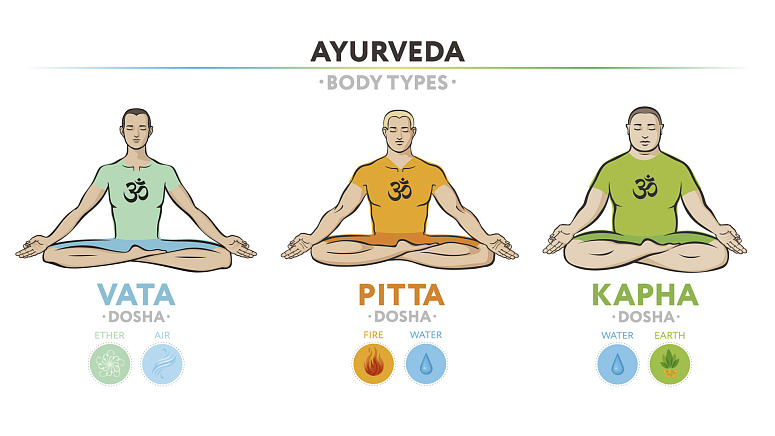This theory is a way of describing the human body and the processes that take place within it.
Dosha (from Sanskrit: दोष, doṣa — defect) is a non-material substance that is not manifested in the physical world. Nonetheless, it is an integral characteristic of the human body. The principle of the three doshas shapes the human's physical body and influences its psycho-emotional state. The three forces or energies of Vata (Ether and Air), Pitta (Fire and Water), and Kapha (Water and Earth) are formed by the predominant primary elements (Mahabhutas) in each of the doshas.
Mahabhuta can be translated from Sanskrit as 'great spirit' (from Sanskrit: महाभूत mahā-bhūta: महा mahā – chief, great and भूत bhūta – spirit). This spirit, i.e., the immaterial substance, forms the material one. As a functional characteristic of the body, Dosha has no material expression. Instead, it is a dynamically changing quality that, if imbalanced, harms the body.
Possessing the qualities of both matter and function, Dhatu (from Sanskrit: धातु dhātu – element) is a set of constituent elements, i.e., the main physical components and tissues of the body that fulfil specific functions.
Mala (from Sanskrit: मला malā – impurity) is a non-functional substance that is naturally excreted from the body. It is not a structural part of the body but waste.
The human body is non-static. Instead, it constantly alters, transforms, and exchanges with the environment. A good example is human metabolism, where the body takes food from the environment, which is transformed into nutrients for building the whole organism. In turn, unnecessary substances are excreted as waste.
Dosha is formed at the time of digestion. At the physical level, it is manifested as chyle (Latin chylus, from Greek: khylós – juice), i.e., nutritious liquid that nourishes and builds the body's tissues under the influence of dosha. A balanced dosha moves through the body along specific channels and forms healthy tissues that, in turn, generate harmonious doshas. However, if imbalanced, dosha starts moving chaotically, leading to the formation of defective tissues and accumulation of ama (from Sanscrit: आम āma – uncooked, unripe) in the body, and eventually to disease.
Ama is an accumulation of the toxins and impurities that clog the body's channels. Ama is not to be confused with mala, i.e., the waste that results from the normal functioning of the dhatu. Among other criteria, the presence of mala could indicate one’s health condition, i.e., which dhatu is affected and which dosha is imbalanced. Although mala, unlike the dhatu, does not function in the body, it does play a crucial role in the body. For example, purisha (from Sanskrit: पुरिष puriṣa – faeces) prevents excessive movement of Vata dosha in the colon and fills it. Mutra (from Sanskrit: मुत्र mutra – urine) and sveda (from Sanskrit: स्वेद sveda – sweat and other excretions) are also mala.
A generalised scheme could express the process described above:
Dhatu → Mala
Dhatu is formed sequentially, eventually producing Ojas (from Sanskrit: ओचसृ ojas – brightness, the vitality of the body, 'power', 'strength', the life-giving energy that spiritualises the human body). Each successive dhatu is formed from the previous one, and each is influenced by dosha. Meanwhile, mala is secreted in this process. There are seven types of dhatu that, for your convenience, are listed in a table, along with their functions: the predominant dosha that determines the functioning of each dhatu and the resulting mala, dhatu, and upadhadu (from Sanskrit: sub issues).
| रस rasa | rasa – lymph, plasma |
|
Rasa is formed directly from digested food. Function: feeling satisfied, satiated, nourishing the whole body and rakta-dhata. Ruling dosha is Kapha. mala – mucus. Sub-tissue derivatives: breast milk, menstrual blood. |
|
| रक्त rakta | rakta – blood, the rough components of blood |
|
Rakta is formed from rasa. Function: maintenance of body vitality, respiration, healthy skin colour, and nourishment of mamsa-dhata. Ruling dosha is Pitta. mala – bile. Derived sub-tissue: blood vessels, tendons. |
|
| मम्स mamsa | mamsa – muscle, meat |
|
Mamsa is formed from rakta. Function: binding, determining the body's shape, nourishing the medha-dhatu and providing raw material for waste generation. Ruling dosha is Kapha. Mala: earwax, mucus and pus from the eyes and the nose. Derived sub-tissues: skin, muscle fat. |
|
| मेघ medha | medha – fat |
|
Medha is formed from mamsa. Function: lubrication, moisturising the eyes and other body parts, protecting and storing energy, filling voids and nourishing the astha-dhata. Ruling dosha is Kapha. Mala: perspiration. Derived sub-tissues: ligaments, joints. |
|
| अस्ति asthi | asthi – bone tissue, bones |
|
Asthi is formed from medhi. Function: forms body structure, supports, protects body organs and nourishes madja-dhatu. Ruling dosha is Vata. Mala: hair, nails. Derived sub-tissue: teeth. |
|
| मच्च majja | majja – bone marrow, nerves |
|
Majja is formed from the astha. Function: maintains strength and immunity, fills bones, moisturises and nourishes shukra-dhatu. Ruling dosha is Kapha. Mala: tears. |
|
| शुक्र shukra | shukra/artava – sperm, ova, reproductive tissues |
|
Schukra is formed from majji. Function: procreation, maintenance of strength, inspiration and sexual excitation. Ruling dosha is Kapha. |
Doshas provide energy for the body's tissues, which in turn create the structure for the dosha’s functioning.
It is worth noting that the transformation processes in all seven tissues occur under the influence of three doshas, but the most influential is the ruling one. Doshas, in turn, depend on the transformation processes in each of the seven tissues. The whole chain of tissue formation in the human body is a sequence of two-way dynamic processes of balance and interaction between dhatu and doshas, i.e., material and immaterial aspects.
The Dosha Dhatu Mala model illustrates how a healthy spirit shapes a healthy body and explains why a healthy body has a healthy spirit.
